Dragon fruit, also known as pitaya, is a tropical fruit that is gaining popularity around the world for its unique appearance and purported health benefits. This tropical cactus is not only easy to grow, but it also produces delicious and nutritious fruit! We’ll explore some of the key factors that go into cultivating dragon fruit and provide tips for those looking to try their hand at growing this tasty and beneficial fruit. So, stop draggin’ your feet and learn how to grow dragon fruit in our complete guide! Let’s dig in!
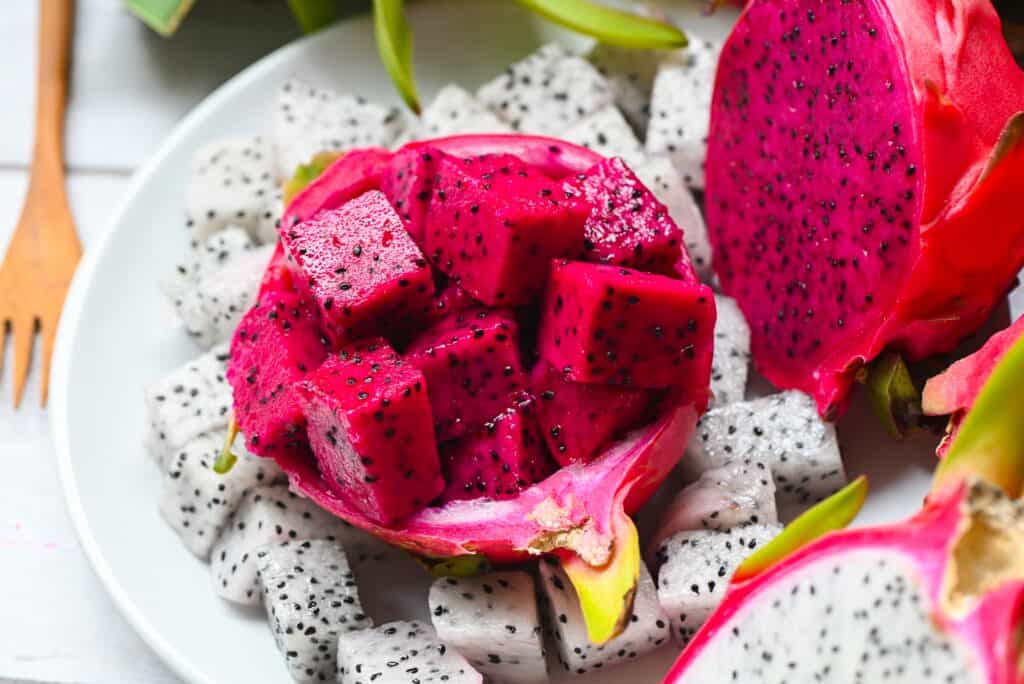
Dragon fruit, also known as pitaya, is a tropical fruit that is gaining popularity around the world for its unique appearance and purported health benefits.
©Poring Studio/Shutterstock.com
What is Dragon Fruit?
Dragon fruit (Selenicereus) is a tropical fruit that comes from cacti in the genus Selenicereus. It is native to Central and South America but is now widely cultivated in other parts of the world, including Southeast Asia and Australia. Until quite recently dragon fruits were contained in two separate genera, Hylocereus and Selenicereus. However, in 2017, the International Botanical Congress changed the classification of dragon fruit from two genera to one genus, Selenicereus.
These tropical fruits are recognized for their colorful appearance, with a bright red or yellow exterior and green scales resembling a dragon’s skin. The flesh inside the fruit is white or pink and speckled with tiny black seeds. The flavor is often described as mild and sweet, with a texture similar to kiwi. Dragon fruit is a good source of nutrients, including vitamin C, fiber, and antioxidants. It is also low in calories and fat, making it a popular choice for those who are health-conscious. Dragon fruit can be eaten on its own or used in a variety of dishes, such as smoothies, salads, and desserts.
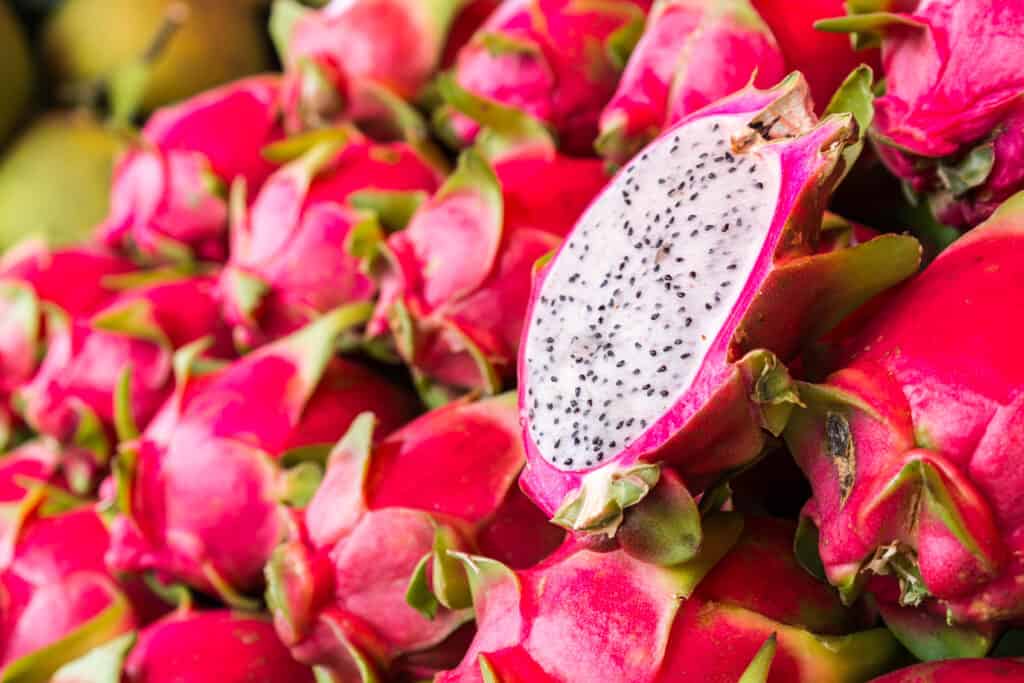
Dragon fruits are recognized for their colorful appearance, with a bright red or yellow exterior and green scales resembling a dragon’s skin.
©Pitchayarat Chootai/Shutterstock.com
How to Grow Dragon Fruit: Selection
There are several different varieties of dragon fruit. The exact number of varieties is difficult to determine, as new varieties are consistently being developed through selective breeding and hybridization. However, some of the most common varieties of dragon fruit include:
- Hylocereus undatus, the white-fleshed pitahaya, is the most widely grown variety of dragon fruit. It has a pink exterior with green scales and white flesh that is sweet and mild in flavor.
- Hylocereus polyrhizus is a variety with a bright red exterior and green scales. and a slightly sweeter flavor than the undatus variety. This variety, also called Bloody Mary, has vibrant pink-to-red flesh that is sweet. It is grown in Panama and Colombia.
- Hylocereus megalanthus, commonly known as yellow dragon fruit has a yellow exterior with green scales, white flesh, and a slightly sweeter flavor.
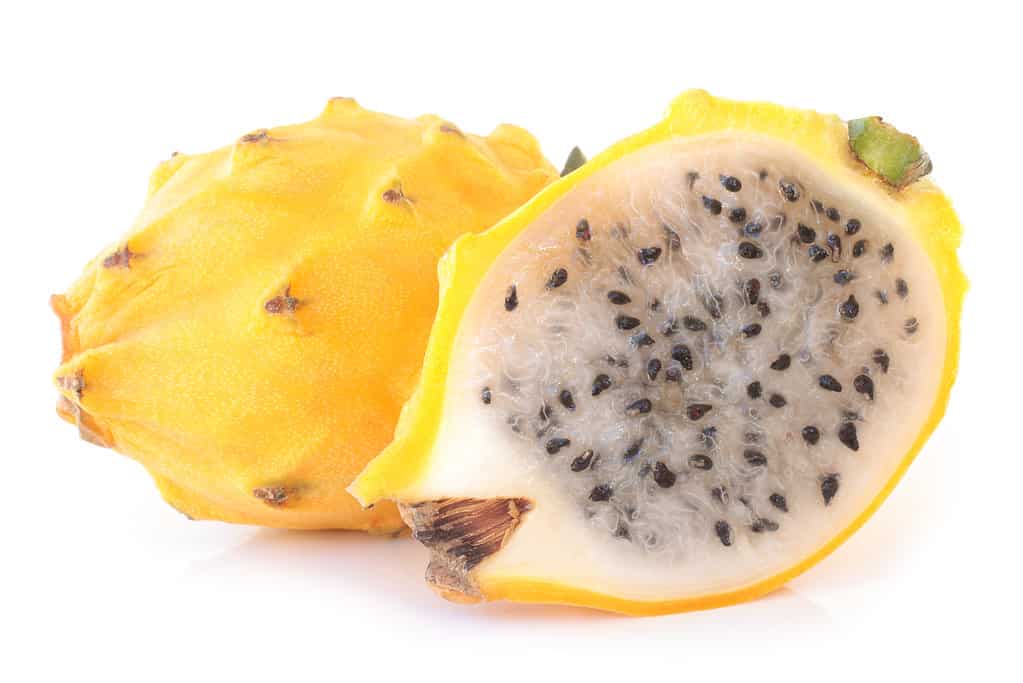
, commonly known as yellow dragon fruit has a yellow exterior with green scales, white flesh, and a slightly sweeter flavor.
©Olga Popova/Shutterstock.com
How to Grow Dragon Fruit: Requirements
The moonlight cactus is a genus of flowering tropical succulents that produce dragon fruit. Moonlight cacti thrive in warm, humid climates. They are not well-suited to cold temperatures or frost. These cacti are typically grown in USDA Hardiness Zones 10-11. You can discover your USDA Zone here.
In Zone 10, which includes parts of Southern California, Southern Florida, and Hawaii, moonlight cacti (and subsequently dragon fruit) can be grown outdoors year-round. In Zone 11, which includes areas such as Puerto Rico and the Virgin Islands, growing dragon fruit meets with even greater success.
Dragon fruit can still be grown in colder climates, but it will need to be grown in a greenhouse or other protected environment to provide the necessary warmth and humidity. Some growers may opt to grow dragon fruit in pots or containers, which can be moved indoors during the colder months.

The moonlight cactus is a genus of flowering tropical succulents that produce dragon fruit.
©apiguide/Shutterstock.com
Soil Requirements
Moonlight cacti prefer a soil pH range between 6.0 and 7.0, which is slightly acidic to neutral. Soil that is too acidic or too alkaline can affect the plant’s ability to absorb nutrients and can lead to poor growth and reduced fruit production.
It’s a good idea to test the pH of your soil before planting moonlight cacti to ensure that it falls within the optimal range. This can be accomplished using a soil pH testing kit, which can be purchased at most garden centers or online. If the soil pH is outside the optimal range, you can adjust it by adding soil amendments such as lime (to raise the pH) or sulfur (to lower the pH). You can learn more about testing your soil here.
Dragon fruit requires warm temperatures, well-draining soil, and plenty of sunlight and water to thrive. If these conditions are met, dragon fruit can be a rewarding and delicious crop to grow.

It’s a good idea to test the pH of your soil before planting moonlight cacti to ensure that it falls within the optimal range.
©Tama2u/Shutterstock.com
Pollination Requirements
While dragon fruit flowers are capable of self-pollination, they generally require cross-pollination to produce fruit. This is because dragon fruit plants have flowers that contain both male and female reproductive organs, but the flowers are typically not self-fertile.
To produce fruit, the flowers must be pollinated by a separate individual, either through natural pollination by insects or through hand pollination by a grower. While it is possible for a dragon fruit plant to self-pollinate, the resulting fruit may not be of as high quality as fruit produced through cross-pollination, as self-pollination can result in reduced genetic diversity and lower overall fruit quality.
Therefore, it is generally recommended to plant multiple dragon fruit plants of different cultivars in close proximity to ensure adequate cross-pollination and optimal fruit production.

While it is possible for dragon fruit to self-pollinate, the resulting fruit may not be of as high quality as fruit produced through cross-pollination.
©iStock.com/krungchingpixs
Timing is Everything
While dragon fruit flowers do contain both male and female reproductive organs, they are not self-fertile because the timing of the maturation of these organs does not often coincide. In most cases, the male reproductive organs (the stamens) will mature before the female reproductive organs (the stigma and ovary) are receptive to pollen. For a flower to be fertilized and produce fruit, pollen must be transferred from the stamen to the stigma, where it can then travel down to the ovary and fertilize the eggs. If the timing of the maturation of these organs does not overlap, self-fertilization cannot occur.
Even when the timing of the maturation of these organs does coincide, it is generally believed that cross-pollination between different varieties of dragon fruit can lead to better fruit quality. For this reason, many growers prefer cross-pollination to self-pollination.
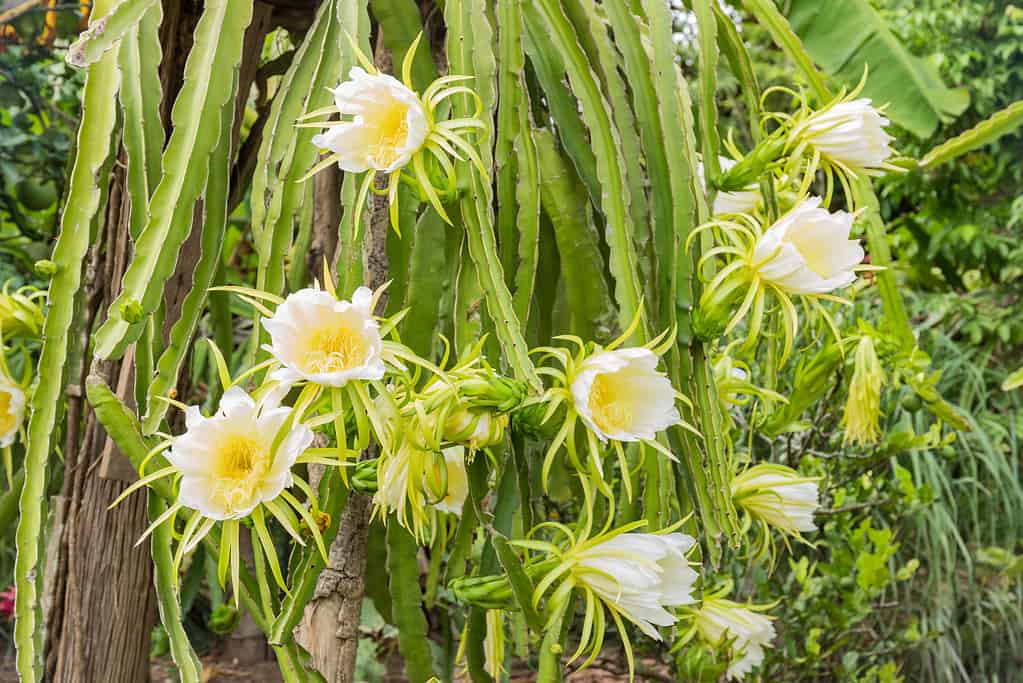
it is generally believed that cross-pollination between different varieties of dragon fruit can lead to better fruit quality.
©somyot pattana/Shutterstock.com
How to Grow Dragon Fruit: Methods of Propagation
Dragon fruit (moonlight cacti) can be propagated through two main methods: cuttings and seeds. Each method has its pros and cons, and the choice depends on various factors such as availability, time, and desired results.

Propagating dragon fruit through cuttings involves taking cuttings from a healthy parent plant and planting them in well-draining soil.
©Verin/Shutterstock.com
How to Grow Dragon Fruit: Propagation from Cuttings
Propagating dragon fruit through cuttings involves taking cuttings from healthy, mature leaves from the parent plant and planting them in well-draining soil. This method is faster and easier than growing from seeds since cuttings already have a head start and will begin producing fruit sooner than seedlings. However, cuttings are clones of the parent plant, so there is a risk of propagating any diseases or genetic abnormalities present in the original plant.
Pros:
- Faster and easier than growing from seeds
- Cuttings are clones of the parent plant and will have the same characteristics
- May begin producing fruit sooner than seedlings
Cons:
- Risk of propagating any diseases or genetic abnormalities present in the original plant
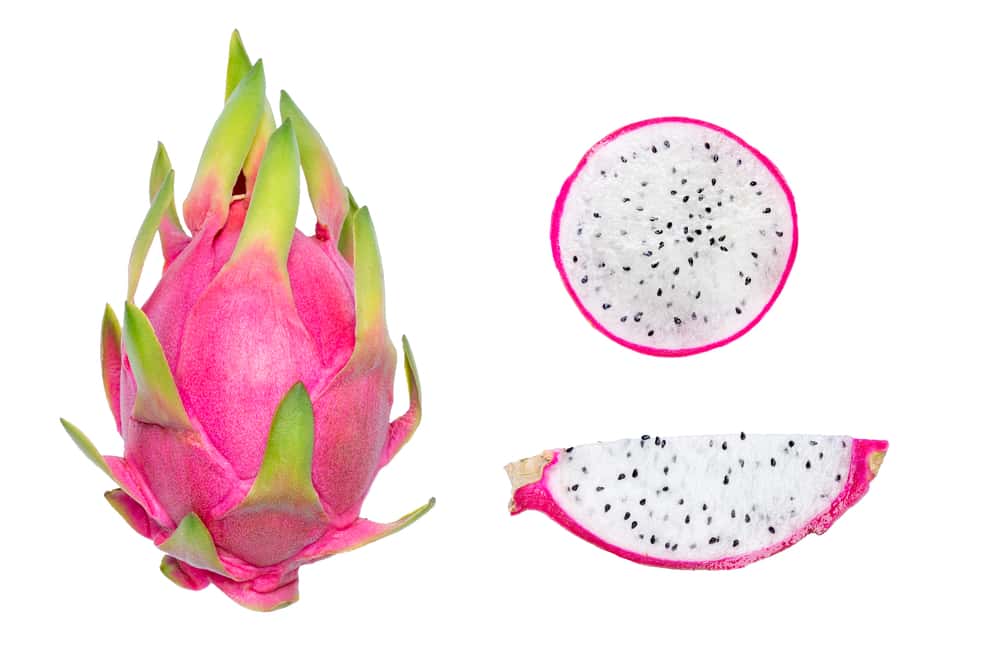
Growing dragon fruit from seeds involves planting mature fruit in well-draining soil and providing the right conditions for germination.
©Pasuwan/Shutterstock.com
How to Grow Dragon Fruit: Starting From Seed
Growing dragon fruit from seeds involves planting mature fruit in well-draining soil and providing the right conditions for germination. This method takes longer and requires more patience, but it allows for genetic diversity, which can be beneficial for plant health and vigor
Pros:
- Allows for genetic diversity, which can be beneficial for plant health and vigor
- No risk of propagating any diseases or genetic abnormalities present in the original plant
Cons:
- Takes longer and requires more patience than growing from cuttings
- Seedlings may not produce fruit for several years, as they need time to grow and mature.
How to Grow Dragon Fruit: Propagation By Leaf Cutting
Growing a moonlight cactus in a container is a splendid option for those who live in colder climates or have limited outdoor space. Growing dragon fruit in a container allows you to move the plant indoors during the colder months or to place it in a location where it can receive optimal sunlight.
When growing dragon fruit in a container, it’s important to choose a container that is large enough to accommodate the plant’s growth. A container with a diameter of at least 18-24 inches (45-60 cm) is recommended, with a depth of at least 12-18 inches (30-45 cm). The container should also have good drainage to prevent waterlogging and root rot. A rolling plant caddy would also be a good investment, allowing for flexibility and ease of movement.

Growing dragon fruit in a container allows you to move the plant indoors during the colder months or to place it in a location where it can receive optimal sunlight.
©Arie Rinanda/Shutterstock.com
Preparing the Container
Fill the container with a well-draining potting mix that is rich in organic matter, like the premixed cactus/succulent soil that is available at garden centers, or a mixture of sand, perlite, and peat moss. Adding slow-release fertilizer to the soil provides the plant with nutrients.
Choose a healthy leaf that is fully mature, but not old and woody. It’s best to choose a leaf that is green and plump. Using a sharp, sterile knife or scissors, cut the leaf. The blade can be sterilized by boiling or wiping it down with alcohol. Allow the leaf cutting to dry for a few days until the cut end has formed a callus. This helps prevent infection and promotes the formation of new roots. Once the cutting has developed a callus, it’s time to plant the cutting in the prepared container.
Plant the leaf cutting approximately 1 inch (2.5 cm) deep in the soil. Water the soil lightly and cover the pot with a plastic bag or plastic wrap to create a humid environment. After a few weeks, new roots should start to grow from the buried portion of the leaf cutting. Once the roots have developed and the new plant has started to grow, the plastic cover can be removed. Make sure the cactus receives plenty of sunlight, ideally 6-8 hours per day. Water the plant regularly, keeping the soil evenly moist until the cutting has had a chance to take root. As the cactus matures, allow the soil to dry out between waterings.
Preparing for the Harvest
The time it takes for a dragon fruit plant to grow from a cutting to produce fruit can vary depending on several factors, including the age of the cutting, the growing conditions, and the variety of dragon fruit. However, on average, it can take anywhere from 1 to 3 years for a dragon fruit plant to produce fruit after it has been propagated from a cutting.

It can take anywhere from 1 to 3 years for a dragon fruit plant to produce fruit after it has been propagated from a cutting.
©Snaps3/Shutterstock.com
How to Grow Dragon Fruit: Growing from Seed
Growing dragon fruit from seed requires patience, as it will take 5-7 years several years for the plant to mature and produce fruit. When growing dragon fruit from seed, there is a chance that the resulting plant may not be true to type. This is because dragon fruit plants can cross-pollinate with other dragon fruit plants, and the resulting seeds may produce plants with different characteristics than the parent plant.

Growing dragon fruit from seed requires patience, as it will take 5-7 years several years for the plant to mature and produce fruit.
©Mikulas P/Shutterstock.com
If you are growing dragon fruit from seed, you may end up with a plant that produces fruit with slightly different characteristics than the parent plant. To ensure that you get a dragon fruit plant that is true to type, it’s best to propagate the plant from stem cuttings rather than from seed. This allows you to create a new plant that is genetically identical to the parent plant and will produce fruit with the same characteristics as the parent plant.
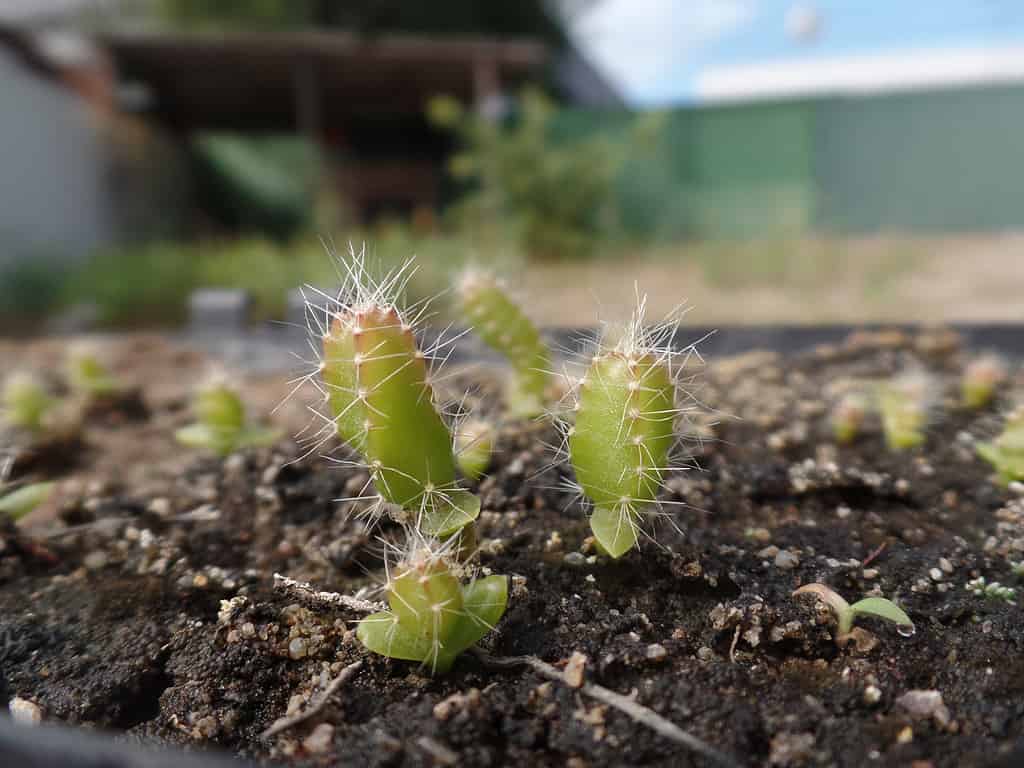
If you are growing dragon fruit from seed, you may end up with a plant that produces fruit with slightly different characteristics than the parent plant.
©Vinicius Moreira da Silva/Shutterstock.com
Step-by-Step Guide for Growing Dragon Fruit from Seed
To grow dragon fruit from seed:
- Obtain dragon fruit seeds from a reputable source. You can purchase them online or from a garden center.
- Soak the seeds in water for 24 hours to soften the seed coat and promote germination.
- Fill a small pot or container with a well-draining potting mix. Dragon fruit prefers slightly acidic soil with a pH between 6.0 and 7.0.
- Plant the seeds about 1/4 inch (0.6 cm) deep in the soil and cover them with a thin layer of soil.
- Water the soil lightly and place the pot in a warm, bright location but away from direct sunlight.
- Keep the soil evenly moist while the dragon fruit seeds germinate. This can take 2-3 weeks.
- Once the seedlings have emerged, keep them in a warm, bright location with indirect sunlight.
- After a few weeks, the seedlings can be transplanted into larger pots or containers. Use a well-draining soil mix and ensure that the pots have drainage holes to prevent waterlogging.
- Provide regular water and fertilization to promote healthy growth. Dragon fruit is a fast-growing plant and can benefit from regular feeding with a balanced fertilizer.
- As the plant grows, it may need support in the form of a trellis or stake. Dragon fruit is a climbing plant that can grow several feet long.
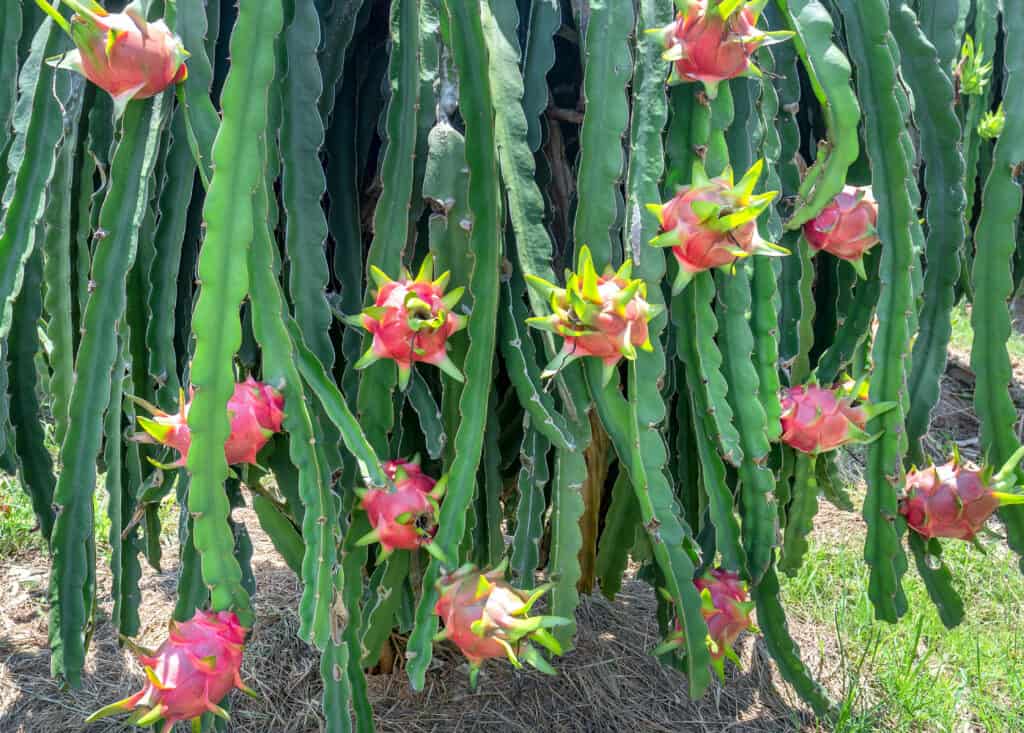
Dragon fruit is a fast-growing plant and can benefit from regular feeding with a balanced fertilizer.
©iStock.com/HuyThoai
Five Fast Facts about Dragon Fruit
- Dragon fruit is used in traditional medicine to treat a variety of ailments, including high blood pressure, diabetes, and inflammation.
- Dragon fruit grows on a climbing cactus that can grow up to 10 feet (3 m) high.
- Dragon fruit flowers bloom at night.
- Vietnam is the leading producer of dragon fruit in the world.
- Locally called Thanh Long, dragon fruit is considered the national fruit of Vietnam.
The photo featured at the top of this post is © iStock.com/HuyThoai
Thank you for reading! Have some feedback for us? Contact the AZ Animals editorial team.







